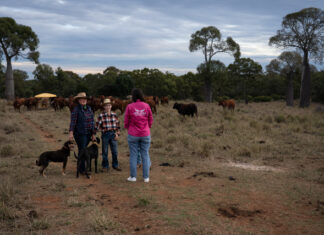The inclusion of a fully-operational carbon project is expected to help push the price of Queensland cattle breeding enterprise Coralie to about $20 million.
Run by Upscale Funds Management, the 70,500-hectare station near Croydon in the Savannah Gulf is being offered on a “bare basis“, meaning without livestock.
Sales agent JLL Agribusiness senior director Chris Holgar said Coralie’s fully-stratified Human Induced Regeneration (HIR) carbon project – focused on supporting the regeneration of native vegetation – began in 2020 in partnership with the local Tagalaka People.
He said the project had been audited by the clean energy regulator.
It is set to generate more than 230,000 Australian Carbon Credit Units (ACCUs) during its 25-year term, with the first units due for imminent issue. Uniquely, the credits are transferred to the landowner.
“The benefit of HIR carbon projects such as this within the Gulf region is their complementary purpose with pastoralism,” Mr Holgar said.
“They allow for the preservation of meaningful carrying capacity via rotational grazing across the holding, while preserving its underlying productivity.”
JLL Agribusiness director Clayton Smith said Coralie, located 70 kilometres south-west of Croydon and capable of running 6000 adult equivalents, has little comparable competition in the market.
“With its unique opportunity to acquire an efficient, fully-developed breeding enterprise complemented by a fully registered and unconditional carbon project, Coralie represents a combination seldom seen in the market,” he said.
“We expect to draw strong interest from both pastoral and carbon industry participants.”
JLL Agribusiness senior director Geoff Warriner said the holding was ideally suited to a stand alone breeder enterprise or as part of a larger supply chain providing cattle to both domestic markets and/or for export through the Port of Townsville.
He noted the significant program of infrastructure investment that had taken place since Upscale acquired the property in 2019, much of it tied to implementation of the carbon project.
“The property has been the beneficiary of large-scale capital works, notably the development of 20 large dams and the building of more than 33km of fencing,” he said.
“These have reduced grazing pressure and drawn into play areas that had previously been underutilised.”
CARBON PROJECT INFORMATION AT A GLANCE
Source: Clean Energy Regulator, cer.gov.au
* The Australian Carbon Credit Unit (ACCU) Scheme encourages projects that reduce emissions or store carbon by, for example, changing the way vegetation is managed.
* Each ACCU represents one tonne of carbon dioxide removed or avoided. ACCUs can be traded or sold on the carbon market.
* The Human Induced Regeneration method is designed to achieve forest cover via eligible activities that encourage regeneration of Australian native tree species indigenous to a project’s local area.







